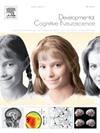超越部分的总和:计算障碍-阅读障碍共病的多维方法,整合大脑,行为和遗传学的研究。
IF 4.6
2区 医学
Q1 NEUROSCIENCES
引用次数: 0
摘要
数学学习障碍(MD)和阅读学习障碍(RD)是干扰学业和日常生活任务成功的持续性疾病,不能归因于智力残疾、感觉缺陷或环境因素。据估计,MD和RD的患病率为学龄儿童的5- %,其合并症(MDRD)非常普遍,约40% %的MD患儿也患有RD。尽管合并症发生率很高,但与孤立情况相比,MDRD的研究受到的关注较少,其神经认知机制尚不清楚。在本研究中,我们回顾了行为、神经影像学和遗传MDRD研究,并讨论了它们如何支持当前的MDRD模型,包括:(1)加性模型(additive model),认为MDRD是由MD或RD特有的神经认知缺陷引起的;(2)域通用缺陷模型(domain-general deficit model),认为MDRD是由执行功能缺陷引起的;(3)风险增加模型(increase risk model),认为MDRD是由RD特有的语音缺陷引起的。我们建议通过整合多缺陷和维度模型来更新MDRD模型,以建立一个统一的研究和诊断框架,该框架考虑了数学、阅读和领域通用技能的多个维度。这个统一的框架强调了整体功能诊断的重要性。本文章由计算机程序翻译,如有差异,请以英文原文为准。
Beyond the sum of their parts: A multi-dimensional approach to dyscalculia-dyslexia comorbidity integrating studies of the brain, behavior, and genetics
Mathematics learning disorders (MD) and reading learning disorders (RD) are persistent conditions that interfere with success in academic and daily-life tasks, and cannot be attributed to intellectual disabilities, sensory deficits, or environmental factors. Prevalence rates of MD and RD are estimated at 5–10 % of school-age children, and their comorbidity (MDRD) is highly prevalent, with around 40 % of children with MD also experiencing RD. Despite this high comorbidity rate, research on MDRD has received less attention compared to isolated conditions, leaving its neurocognitive mechanisms unclear. In this study, we review behavioral, neuroimaging, and genetic MDRD research and discuss how they support current MDRD models, including the: (1) additive model, which proposes that MDRD results from the addition of neurocognitive deficits unique to MD or RD, (2) domain-general deficits model, which proposes that MDRD stems from executive function deficits, and (3) increased risk model, which proposes that MDRD emerges from phonological deficits characteristic of RD. Further, we recommend updating models of MDRD by integrating the multiple deficit and dimensional models to build a unified framework for research and diagnosis that considers multiple dimensions of mathematics, reading, and domain-general skills. This unified framework highlights the importance of a holistic, functional diagnosis.
求助全文
通过发布文献求助,成功后即可免费获取论文全文。
去求助
来源期刊

Developmental Cognitive Neuroscience
NEUROSCIENCES-
CiteScore
7.60
自引率
10.60%
发文量
124
审稿时长
6-12 weeks
期刊介绍:
The journal publishes theoretical and research papers on cognitive brain development, from infancy through childhood and adolescence and into adulthood. It covers neurocognitive development and neurocognitive processing in both typical and atypical development, including social and affective aspects. Appropriate methodologies for the journal include, but are not limited to, functional neuroimaging (fMRI and MEG), electrophysiology (EEG and ERP), NIRS and transcranial magnetic stimulation, as well as other basic neuroscience approaches using cellular and animal models that directly address cognitive brain development, patient studies, case studies, post-mortem studies and pharmacological studies.
 求助内容:
求助内容: 应助结果提醒方式:
应助结果提醒方式:


